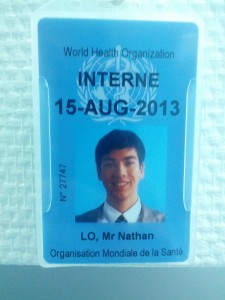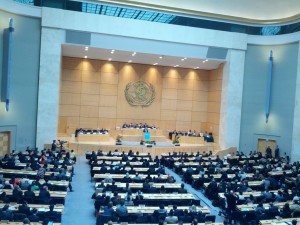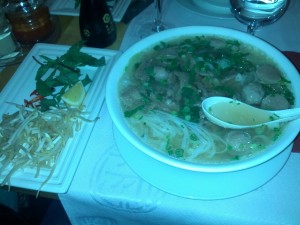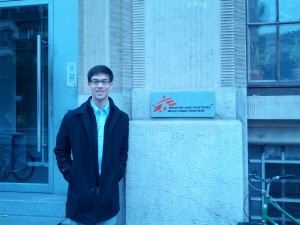Hello all!
My name is Nathan Lo, and I am a BTB International Fellow interning with the World Health Organization (WHO) in Geneva, Switzerland. While not a traditional BTB intern (i.e. working with student-initiated technologies in a health setting of a developing country), my work strives to accomplish a similar goal. As an intern of the Medical Devices Unit, my project focuses on increasing access to life-saving medical devices in resource-poor settings, a goal close to the heart of Rice 360.
As a recent graduate of Rice University in bioengineering and global health technologies, I have spent the past four years involved in the design of medical devices intended to address health needs in resource-limited settings. More recently however, I have become much more interested in how to commercialize these technologies. Essentially, with a product like the bubble CPAP – a low-cost, clinically effective medical device – how do we take the CPAP out of the laboratory and get it to every hospital (and premature baby) than needs it?
In a resource-poor setting, this process of commercialization can be viewed as a logistical nightmare. I recently gave a business pitch for my senior design project – a wireless vital signs monitoring system for hospitals in developing countries – and after the pitch, an investor-judge told us to “Forget saving Africa, go to the United States and make money.” With slim profit margins, underdeveloped local capacity, limited manufacturing capabilities, and a host of other unique challenges, the “sustainable” scaling up of a health technology in a developing setting is an enormous challenge. Despite these challenges, and against the advice of such people, institutes like Rice 360 exist and continue to work to address this global health challenge. I believe that this is a perfect example of something worth fighting for.
The idea to work at the World Health Organization first popped into my mind while searching for examples of successfully commercialized BTB-like health technologies as part of a grant proposal. I came across the WHO Compendium of Innovative Health Technologies. This compendium serves as a centralized booklet of medical devices like the Rice bubble CPAP – they address the health needs of a resource-limited setting, but have yet to be commercialized. In my mind, the Compendium’s key value is that it can bridge the gap between engineers and investors to commercialize medical devices that have the potential to make significant improvements to global health. After seeing this report (and having a background in policy), I became interested in how to address this gap between technical innovation and sustainable implementation from a policy-level at the World Health Organization.
After securing a WHO intern position and funding thanks to the James T. Wagner Fellowship, I am in Geneva, Switzerland, and three weeks into my work. I have become fully immersed in our project, the Phase II of the report, “Local production and technology transfer to increase access to medical devices in low resource settings.” The Phase I report can be found here. My portion of the project is broken down into three major activities:
(1) Revise the feasibility tool, which is a series of questions that assess the potential for successful commercialization of a medical device in a specified low-resource setting, with special attention given to the role of local production in the scale-up process.
(2) Write country profiles for South Africa and Nigeria, which aim to give readers an understanding of the biomedical and business landscape needed if they were to scale-up a medical technology in that country.
(3) Assist in the coordination of in-country projects (e.g. surveys on barriers to local production and commercialization of medical technologies).
Aside from this project, I have been involved in most other projects in the Medical Devices Unit in a smaller capacity.
As an aspiring physician interested in global health, research, and policy, working for the World Health Organization is a dream come true. A symbol of the universal goal of man to improve the health of the poorest populations, I have always loved the thought of the organization. To think that I am working in the building where such entities as the “3 by 5” initiative were first initiated is an incredible thought. I came to the WHO, in part, to meet and learn from passionate, hard-working individuals that each have their altruistic ideal they fight their life for, and luckily, this has not been a disappointment. A typical workday for me is from 8:30am – 6:30pm, and I am the last to arrive and the first to leave. If the Medical Devices Unit is representative of the WHO, I am proud to be part of such a devoted, relentless group of individuals.
On a personal note, I recently was fortunate enough to see a speech from a personally inspirational figure, Dr. Jim Kim. As president of the World Bank Group, he spoke at the United Nations during the 66th World Health Assembly, and gave a truly remarkable and inspirational speech. See link for a transcript of the speech.
As for life in Geneva, the word that comes to mind is: expensive. The average dinner is 19.00 CHF (slightly stronger than the USD), if you’re lucky (I did have some luck in finding a pack of 24 popsicles for 4.30 CHF). Geneva does have it perks however, a beautiful lake, nice European architecture, and a hub of NGO activity (e.g. MSF!).
Thank you for reading, and feel free to post comments. If you want to email: nathanlo3579@gmail.com.




